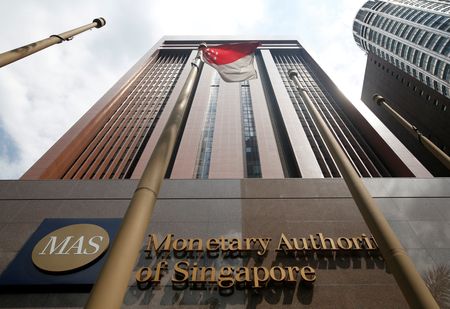
SINGAPORE (Reuters) -Singapore’s central bank on Friday tightened monetary policy for the fourth time this year to rein in inflation running near a 14-year high, and left the door open for further policy action amid upside risks to the price outlook and global uncertainty.
The Monetary Authority of Singapore (MAS), at a scheduled policy meeting, said it will re-centre the mid-point of the exchange rate policy band known as the Nominal Effective Exchange Rate, or S$NEER. There will be no change to the slope and width of the band.
MAS has made two off-cycle tightening moves this year, in January and July, as inflation in the city-state remains elevated.
This is the fifth round of tightening since last October, and some analysts said more policy action was possible.
Selena Ling, head of treasury research and strategy at OCBC, said the MAS move “suggests that there will be less concern about downside growth risks, which can be taken care of through the upcoming budget.”
While MAS used only one lever to tighten policy, she expects there could be “more ammunition to come” at next April’s scheduled review.
On Friday, the central bank said all the tightening moves so far will further reduce imported inflation but cautioned about persistent cost pressures.
“The Singapore economy will grow at a slower pace in tandem with weakening global demand,” MAS said.
“However, core inflation will stay elevated over the next few quarters, as imported inflation remains significant and a tight labour market supports strong wage increases,” it added in its statement.
The Singapore dollar was up about 0.3% to $1.4256 per U.S. dollar after the policy decision.
OUTLOOK RISKS
Analysts said the main reason for MAS to tighten only via one lever instead of two or more was because it sees that persistent inflation will start to ease. They were split on how aggressively MAS would tighten this round.
The MAS manages monetary policy through exchange rate settings, rather than interest rates, as trade flows dwarf its economy.
It adjusts its policy via three levers: the slope, mid-point and width of the policy band, which let the Singapore dollar rise or fall against the currencies of its main trading partners within an undisclosed band.
The core inflation rate — the central bank’s favoured price measure – rose to 5.1% in August year-on-year. It was 4.8% in July.
MAS said core inflation is likely to stay at about 5% for the rest of 2022, and into early 2023.
Gross domestic product (GDP) was up 4.4% in July-September on a year-on-year basis, according to advance estimates from the Ministry of Trade and Industry also released on Friday.
On a quarter-on-quarter seasonally adjusted basis, GDP expanded 1.5% in July-September.
“Q3 GDP obviously benefited from domestic and border restrictions being eased,” said Song Seng Wun, an economist at CIMB Private Banking.
The central bank said growth in Singapore’s key trading partners should stay positive in 2023, but warned of risks to the outlook.
“However, further shocks, including from geopolitical tensions, could drive inflation higher and cause full-year recessions in some key economies.”
(Reporting by Joe Brock, Anshuman Daga, Xinghui Kok, Chen Lin; Editing by Kanupriya Kapoor & Shri Navaratnam)

